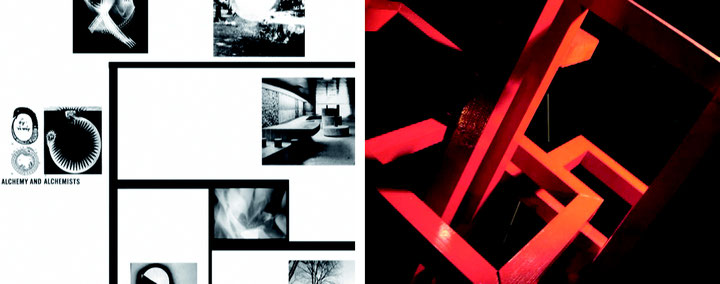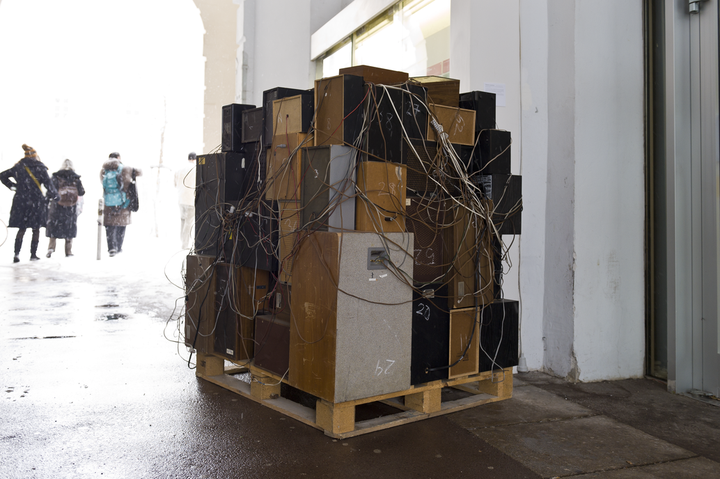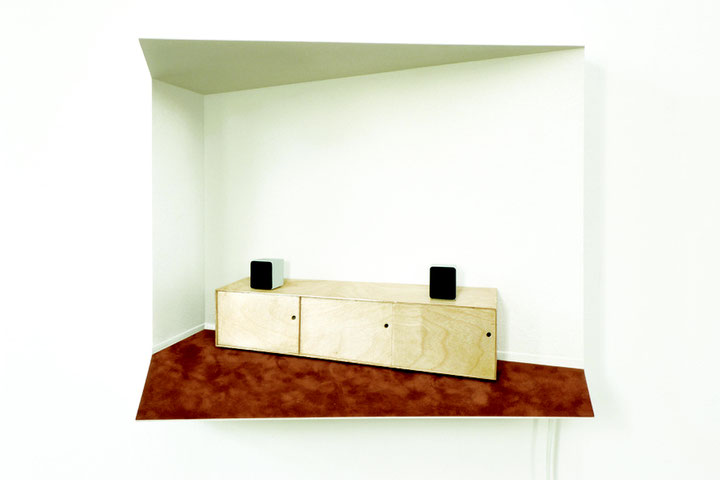Held in Wuppertal's Galerie Parnass in 1963, Nam June Paik's exhibition “Exposition of Music – Electronic Television” is considered a milestone in the history of video art. For the artist himself however, it constituted “an application and visual expansion of electronic music”1: transposing the techniques he had learnt in the WDR electronic music studio to the image, he presented modified television sets displaying distorted visual patterns that could not be predetermined or fixed2 – and contrasted sharply with the rigorously structured, serial tape compositions favoured by many composers at the time. The transposition of music into image was a means of foregrounding indeterminism – à la John Cage – a concept Paik regarded as “today's central problem in ethics and aesthetics, and perhaps also in physics and in the economy.”3
Along with other events of that time, like the legendary interdisciplinary performance series “9 Evenings: Theatre and Engineering” (New York, 1966), “Exposition of Music – Electronic Television” raised more questions than it answered about the potential of boundary-crossing artforms and the philosophical and conceptual implications thereof. Fifty years on, these questions are still the subject of debate and continue to be addressed in exhibitions – among them two shows that took place recently in Vienna. “Laocoon II”, curated by Severin Dünser at Coco, went back to first principles: the earliest systematic formulation of the boundaries between the arts, as laid out in G. E. Lessing's 1766 tract Laocoon: An Essay upon the Limits of Poetry and Painting. In this work, Lessing sought to define the boundaries between poetry and painting by arguing that the first consists of sounds that succeed each other in time, and the second of elements juxtaposed in space. Among the works on show in “Laocoon II”, Heimo Zobernig's Untitled (1987) - a primed white canvas divided into rectangles of different sizes, each bearing the name of a colour – best illustrated Lessing's distinction: upon reading the names of the colours, the viewer was able to imagine them one by one. Only by contemplating the entire canvas could he imagine all the colours next to each other at the same time. The work highlighted the complementarity of our faculties of reception, which function differently in the case of text and image.
However Lessing went on to concede that poetry and painting exist both in time and in space, even if poetry can only indirectly refer to spatial forms and painting only allude to temporal actions. Other works in the show took up this idea, looking at what happens when spatial and temporal phenomena converge and interact. Julien Bismuth's A Work like a Metaphor (2009) was a headphone piece in which a voice recited a list of metaphors – such as “a work like a hyphen”, “a work like a break in one's voice”. The listener attempted to visualize these works, while also reinterpreting the pieces around him in the light of what he heard. In the first case, speech engendered spatial forms and in the second, it lent existing works a new meaning. Likewise exploring the relationship between speech and spatial forms, Falke Pisano's video A Sculpture turning into a Conversation, Part Zero and Part One (2006), featured a narrative loosely based around a sculpture, partial views of which flitted across the screen. A composite sculpture took shape in the listener's head, as he filled in the gaps between sound and visuals. Here, the two media became intertwined. Lessing's distinction may appear self-evident, but as he himself admitted, it often breaks down. The exhibition questioned the validity of the unshakeable distinctions between text and image, speech and visuals, on which our daily lives are based.
TONSPUR_expanded ∞ The Loudspeaker, a sound art exhibition curated by Georg Weckwerth in Vienna's Museumsquartier, also contravened the principle of the separation of the spatial and time-based arts. Indeed, the integration of seeing and hearing is one of the central tenets of sound art, as theorist Helga de la Motte-Haber has pointed out: “ Klangkunst [...] ist [...]wesentlich durch neue ästhetische Implikationen definiert, die sich in einem langwierigen historischen Prozess herauskristallisiert haben. Dazu gehört vor allem die Preisgabe eines strengen Unterschieds zwischen räumlichen und zeitlichen Qualitäten, der schon durch die Musikalisierung der Malerei fraglich geworden war und mit der Prozessualisierung der Kunst aufgehoben wurde. Damit aber löste sich auch jener puristische Begriff des künstlerischen Materials auf, der von einer sinnlichen Trennung von Auge und Ohr ausging. Es entstand Kunst, die gleichzeitig gehört und gesehen sein wollte.”4 In the exhibition, videos by Tyler Adams expanded on this idea, subjecting sound, itself a temporal and spatial medium, to further temporal and spatial constraints: in a first video entitled Melt (2010), the sounds emitted by a speaker encased in slowly melting ice became increasingly clear over time, while a second video, Vibration (2010), showed a speaker placed on the ground oscillating at a frequency that caused it to move slowly across the space.
The works that assigned length, shape and other 'visual' attributes to sound further challenged our perceptual givens. Maurice van Tellingen's Loudspeaker II (2005), a small-scale three-dimensional model of an ordinary living-room complete with tiny speakers diffusing Beethoven's Eroica, played with the notions of large and small in relation to sound and visuals. Likewise exploring the relation between an object and its sound, Dawn Scarfe's Lenses (2008) consisted of differently shaped wine glasses, each with its own speaker attached to it. The sound of each glass being played was diffused through its speaker, inviting the visitor to reflect on the relationship between shape, size and sound. Experienced through open earphones, Bernhard Leitner's Two Headscapes (2006 and 2010) generated imaginary moving lines of sound in the interior of the head, violating the frontiers between the body and the external world and raising crucial questions with regard to identity and the concept of the self.
The side programme curated by Georg Weckwerth and Hannah Schwegler explored, among other points, the relationship of sound to other disciplines. The philosopher Peter Mahr looked at the loudspeaker from the perspective of phonocentrism - the privileging of speech over writing in Western philosophy. It was Derrida who maintained that speech is privileged on account of its proximity to thought, of which it is held to be the direct expression. Speech thereby represses writing, whose opacity and ambiguities unsettle the stability of meaning - thereby opening the door to indeterminacy, a "central problem", as Paik pointed out. In his lecture, Peter Mahr showed that sound as disseminated by the loudspeaker fulfills such criteria for writing as absence and repeatability, for the loudspeaker replicates sounds whose source may no longer be present. It also translates electrical signals that are encoded - and therefore 'written' – into sound. Paradoxical as it may seem, the loudspeaker represents a challenge to phonocentrism, while also highlighting the intricate relationship between speech and writing, text and sound.
The programme also included a series of reflections and speculations by Charles Stankievech on the interaction between sound and architecture - how architecture can shape a soundfield, for instance, or how the invisible architecture of sound can itself generate space. As transdisciplinary thinking infiltrates all sectors of society, the ever-present questions raised by the relationship between seeing and hearing, poetry and painting, time and space, take on a new urgency.
1 Nam June Paik, quoted in Edith Decker-Phillips, Paik Video, Barrytown, Ltd., New York, 1998, p. 39 [Paik Video. Cologne: DuMont Buchverlag, 1988]. Cf. Nam June Paik – Exposition of Music/Electronic Television Revisited. Vienna, Mumok / Cologne, Walther König 2009
2 Edith Decker-Phillips, Paik Video, op.cit., p. 39.
3 Nam June Paik, quoted in Edith Decker-Phillips, Paik Video, op.cit., p. 39.
4 Helga de la Motte-Haber, “Klangkunst – eine neue Gattung ?”, Klangkunst, Prestel-Verlag, Munich and New York, Akademie der Künste, Berlin, 1996, p. 16.
N.B. the original German titles of the two exhibitions in Vienna are : “Laokoon II” and “TONSPUR_expanded ∞ Der Lautsprecher”. The German title of Bernhard Leitner's work is: Zwei Kopfräume.


